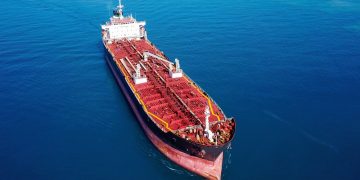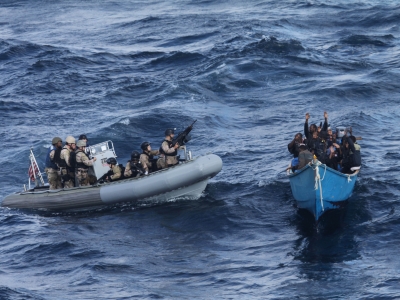After months of uneventful patrolling in the northern Mozambique Channel, the call to action for the South African Navy (SAN) came in early April. Somali-based pirates launched an unsuccess- ful attack on a merchant ship from the Philippines at the northern entrance to the channel.
Perhaps ironically, the SAN vessel on patrol duty was not one of the country’s four modern frigates. They had all done antipiracy patrols in the area, under Operation Copper, and, to give the frigate squadron a break, the navy had sent its replenishment tanker (officially designated as combat support ship by the SAN), the SAS Drakensberg, to shoulder the burden. South African-designed and -built in Durban, the Drakensberg can carry two Denel Oryx helicopters from the South African Air Force’s 22 Squadron, as well as a number of troops. Thus, anti-piracy operations are well within her capabilities.
The pirate mother ship was found by a French Navy patrol aircraft on the third day after the attempted attack. A multinational operation followed, involving the Drakensberg, the Tanzanian Navy (which only operates coastal and inshore patrol boats) and the European Union’s (EU’s) Naval Force Somalia (better known by its code name, Atalanta).
For 24 hours, the Drakensberg and its Oryx searched for the pirates along the cluttered Tanzanian coast, in poor weather conditions. The pirates were trying to make a run for home, but the coordinated response by naval units from four countries cut off all escape. A skiff with five pirates separated from the mother ship and tried to hide on Songo Songo Island, but they were apprehended by the Tanzanians. The mother ship, driven north by the Drakensberg, was intercepted by a Spanish frigate; seven pirates were detained and six Sri Lankan fishermen, held captive for five months, were freed.
“Our people need to understand the challenges we face at sea,” affirmed South African Navy Chief Vice Admiral Johannes Mudimu in his closing address to the 2012 Indian Ocean Naval Symposium (IONS), in Cape Town, in April. “All of us- we’re not safe from this scourge [of piracy and maritime crime]. Adjustments are required to international legal frameworks which currently hamper our dealing with inter- national maritime crime.”
South Africa now has a trilateral agreement with Mozambique and Tanzania which allows the SAN to undertake operations in their waters. “This agreement allows us to conduct all activities aimed at strengthening the SADC (Southern African Development Community) on the east coast,” he explained to a press conference. (It was this agreement which permitted the Drakensberg to search for pirates along the Tanzanian coast.) However, he warned that future international cooper-ation in this regard must be respectful of the sovereignty of the participating States. “We [African countries] will not sacrifice our sovereignty.”
Of course, piracy is not restricted to the Indian Ocean, nor, within this Ocean, is it solely the preserve of marauders based in Somalia. The Malacca Straits, between Malaysia and Indonesia, used to be a piracy hot spot. But effective cooperation between these two countries and Singapore has significantly reduced the incidence of piracy there. And piracy is not the only serious maritime crime to afflict the Indian Ocean. There are also problems of drugs, people and arms smuggling, illegal fishing and terrorism. However, piracy currently overshadows these in its scale and range, and the disruptions it causes makes these other maritime crimes easier. (On the other hand, antipiracy naval patrols also crack down on some of these crimes, most particularly drugs, arms and people smuggling.)
Imperilled Real Economy Pivot
The Indian Ocean is one of the most important geographical fulcrums for the global economy. A great proportion of the world’s real economy (commodities and products) hinges on it. The third-largest ocean, after the Pacific and Atlantic Oceans, it covers 68.556 km2 and accounts for 20% of the globe’s ocean surface. About 33% of the world’s population live in countries that have a coastline on the Indian Ocean. Some 66% of world oil shipments, 50% of global container traffic and 33% of bulk cargo pass through it. It has been estimated that 100 000 cargo ships sail through the Indian Ocean every year. Of these, some 20 000 pass through the Suez Canal. In addition, tankers transport about a billion tons of crude oil annually – the greater part of it shipped east, to feed India, China and Japan.
According to figures presented at IONS by Rear Admiral Habibollah Sayyari, Commander of the Islamic Republic of Iran Navy, in 2000, there were 33 actual and attempted pirate attacks in the Gulf of Aden and the wider Indian Ocean; in 2001 the figure was 19; in 2002 it was 20; in 2003, 23; in 2004, 13; in 2005, 47; in 2006, 24; in 2007, 55; in 2008, 113; in 2009, 218; and in 2010, 219. South African Defence Minister Lindiwe Sisulu highlighted that, in 2006, the global total of people taken hostage at sea was 186, but that, in 2010, the figure for the Indian Ocean alone was 1 016. The International Maritime Bureau reported that of 266 pirate attacks worldwide during the first six months of 2011, more than 60% were attributable to Somali-based pirates. During the first nine months of last year, 24 ships were hijacked by Somali pirates. The global figure was 35. During last September, Somali pirates held 15 vessels and 277 hostages, while 15 people were killed in piracy incidents.
“The [economic] impact of piracy is stronger the nearer you get to Somalia,” pointed out Captain Philip Holihead of the International Maritime Organisation (IMO). “The Kenyans have gone from 13 to 14 cruise ships a year going into Mombasa, to zero.” The Seychelles, whose economy is derived almost entirely from the maritime domain, is one of the few Indian Ocean countries to try to quantify the impact of piracy on its economy. “The Seychelles believes that piracy cut its GDP (gross domestic product) by 8% at the height of the problem,” he reported. The Maldives Coast Guard (which is the maritime arm of the Maldives National Defence Force) recorded two attempted pirate attacks within their country’s Exclusive Economic Zone (EEZ) during 2010. A Bolivian-flagged ship was hijacked within the Maldivian EEZ in March this year.
Addressing the IONS, Sisulu affirmed that the SADC was expecting increased pirate operations off its east coast. During the 12 months from March 2011 to February 2012, there had been 57 pirate attacks in Tanzanian territorial waters, she reported, citing her Tanzanian counterpart. This was “an unprecedented number, but one that is indicative of the relocation of piracy to the SADC ocean”.
The Director of Maritime Safety and Security in Tanzania, Captain King Chiragi, said there had been 30 piracy incidents reported to the Dar es Salaam Maritime Rescue Coordinating Centre (MRCC) in 2010, of which 14 involved ships sailing to or from Tanzania, two had involved ships exploring for oil and gas in Tanzanian waters and 14 had involved ships transiting Tanzanian waters. Three of these attacks were foiled by the Tanzanian Navy. (The Dar es Salaam MRCC also acts as an antipiracy information sharing centre. [ISC])
Worldwide, the cost of piracy has been pegged at between $7-billion and $12- billion. These figures come from a report commissioned by the One Earth Future Foundation. They comprise $176-million for ransoms, $460-million to $3.2-billion in insurance premiums, $2.4-billion to $3- billion in costs of rerouting ships to avoid pirate areas, $363-million to $2.5-billion in security equipment for merchant ships, $2-billion for the cost of naval and air forces deployed to combat piracy, $31-million for the costs of prosecuting pirates, $19.5- million to fund organisations to deter piracy and $1.25-billion in costs to the region’s economies. Most of these costs are incurred in the Indian Ocean. It should be noted, however, that some of the naval and air patrols included in the above calculation would have been undertaken anyway, even if there had been no piracy.
In his address to the IONS, Holihead opined that the actual cost would be around $7- billion and also pointed out that piracy had increased transport costs and so increased prices, as well as having caused declines in tourism and trade. It had further created concerns about the safety of fishing and offshore oil exploration. “Without security and stability in our waters, it will be difficult to implement the ‘blue economy’ – the maritime economy,” African Union (AU)African Integrated Maritime Strategy (AIMS) 2050 task force coordinator Samuel Kame Domguia warned the IONS delegates.
But piracy is of concern to bigger, further-away countries as well. Rear Admiral Monty Khanna, the Indian Navy’s Assistant Chief of Naval Staff (Foreign Cooperation and Naval Intelligence) pointed out that Somali pirates were now operating more than a thousand nautical miles away from their bases.
Vice Admiral Tomohisa Takei, Vice Chief of Maritime Staff of the Japan Maritime Self-Defence Force (the official name of the modern Japanese Navy) highlighted that his country imports 92% of its crude oil, most of it from states in the Indian Ocean region. Between 2 000 and 3 000 ships a year, travelling to or from Japan, pass through the Suez canal each year (and so have to transit the high-risk piracy zone). Most of the iron-ore Japan imports from Australia also passes through the Indian Ocean.
China, too, is concerned. “The peace and stability of the Indian Ocean region are vital to China,” stated Chinese PLA Navy Vice Chief of Logistics Rear Admiral Li Yunqing. (PLA stands for People’s Liberation Army.) He reported that, since its economic reforms, his country imported some 60% of its strategic materials, including oil and minerals, by sea. Nearly 60% of China’s imported oil comes from the Persian Gulf. Some 1 500 Chinese vessels sail through the Gulf of Aden and the waters off the Somali coast every year. And, last year, China became Africa’s biggest trading partner, with a trade volume of some $150-billion. “The international community has common interests and obligations for safety and harmony in the Indian Ocean.”
International Response
“No one nation can fulfil this [antipiracy]role alone,” affirmed Rear Admiral Ahmed Salem, assistant to the Commander-in-Chief of the Logistics Branch of the Egyptian Navy. “Success will come through the hard work of a powerful coalition, through careful international laws, international agreements and bilateral agreements.”
Article 100 of the 1982 United Nations Convention on the Law of the Sea says: “All States shall cooperate to the fullest extent in the repression of piracy on the high seas or in any other place outside the jurisdiction of any State.” Since 2008, the United Nations Security Council (UNSC) has passed ten resolutions specifically on Somali piracy.
UNSC 1816 (2008) was the fundamental resolution, allowing States cooperating with Somalia’s Transitional Federal Government (TFG) to enter Somalia’s territorial waters and use “all necessary means” to suppress piracy and armed robbery at sea. Such operations had to be approved by the TFG and the TFG also had to inform the UN secretary-general about them. The resolution had a validity of only six months. That, of course, was most inadequate, and UNSC 1846 (2008) extended this authorisation by 12 months. Two more subsequent resolutions have since extended this period by further periods of 12 months and the latest of these is still in force. The UN has also assisted Kenya, Mauritius and the Seychelles in revising their law codes, to deal with piracy.
Another counterpiracy initiative is the Djibouti Code, which focuses on sharing information, which is proving crucial to countering the threat. Officially entitled the Code of Conduct for the Repression of Piracy and Armed Robbery Against Ships in the Gulf of Aden and Western Indian Ocean, it was adopted in Djibouti on January 29, 2009. “It has 21 participating states, of which 18 are signatory states,” explained Holihead, who is the head of the IMO’s Djibouti Code of Conduct Implementation Unit. “It is a nonbinding agreement. It is the only code of conduct to counter piracy.”
The member countries of the Djibouti Code speak four different languages and have three different legal systems. The Somali TFG is a member, and South Africa and Mozambique are likely to become signatory members later this year. To help fight piracy, three subregional ISCs have been created, in Sana’a (Yemen), Mombasa (Kenya) and Dar es Salaam (Tanzania). The Sana’a ISC covers Egypt, Jordan, Sudan, Saudi Arabia, Yemen, Oman, the United Arab Emirates, Ethiopia and the de facto states of Somaliland and Puntland. The Mombasa ISC covers Kenya, south and central Somalia, the Seychelles, the Maldives and Mauritius. The Dar es Salaam ISC covers Tanzania, Mozambique, Madagascar, the Comoros, Reunion and South Africa.
Holihead stressed the importance of information sharing within countries as well as between countries and highlighted Tanzania’s success in developing domestic interagency cooperation. “It’s working well.”
The African Integrated Maritime Strategy (AIMS) 2050 is also intended to provide a framework for responding to such threats and problems, among other things, but at a con-tinental level. “It’s ready,” reported Domguia. It is expected that the AIMS 2050 will be approved at the AU summit in June. “And then the hard work will begin,”he affirmed. “It wouldn’t be a good thing, while there is a threat in our waters, [that]we should wait [to implement the AIMS].” The strategy has short- and medium-term objectives as well as those that will only finally be achieved by 2050.
The IONS itself is a forum for promoting cooperation between the navies of the Indian Ocean region and with external fleets operating in the region. In fact, an IONS anti- piracy workshop was hosted by Indonesia in October last year.
On the operational side, there are a variety of forces deployed against the pirates. The biggest ones are the Atalanta task group of the EU, Combined Task Force (CTF) 151 and the North Atlantic Treaty Organisation’s Task Force 508, all of which include ships and aircraft.
CTF 151 falls under the Combined Mari-time Forces (CMF), a 26 nation naval partnership to ensure stability, security and thus prosperity in the waters of the northern Indian Ocean and southern Middle East. (There is also a CTF 150 which targets terrorism and drug smuggling in the Indian Ocean and a CTF 152 in the Persian Gulf.) The CMF includes countries from North America, Europe, the Middle East, Australasia and Asia.
Further, there are national antipiracy task groups from China, India and Russia, and national and regional counter-piracy patrols by the navies of Kenya (the biggest and most capable African navy in the Indian Ocean apart from the SAN), Tanzania and South Africa, and by the Coast Guards of the Maldives, Mauritius and Seychelles.(The navies of Mozambique and Madagascar have very limited capabilities; Mozambican naval personnel are attached to the SAN ships patrolling the Mozambique Channel.)
All these national and international forces seek to cooperate with one another and share information. Further, shipowners have equipped their vessels with protective measures, including armour, antiboarding measures and protected citadels into which crews can retreat and remain safe should pirates board their ships (making it much easier for naval forces to retake the vessels).
All this effort is bearing some fruit. In the first six months of last year, Somali pirates hijacked 21 ships, whereas during the same period in 2010 they hijacked 27. But the Indian Ocean remains a huge expanse, and, in comparison, the number of naval vessels and aircraft deployed to patrol it is tiny. (Moreover, while the overall number of attacks is down, the trend in Southern African waters is, as Sisulu warned, up.) It is against this background that, in March, the EU extended the mandate of the Atalanta force to allow operations against pirates and their infrastructure up to 2 km inland.
Meanwhile, South Africa’s navy chief has assured that Operation Copper (which also involves the South African Air Force, Special Forces and South African Military Health Services as well as the SAN) is con- tinuing uninterruptedly. “The navy is tasked to patrol the northern Mozambique Channel,” said Mudimu. “[But] we can go all the way to Tanzania.” He is also confident that the piracy threat will be overcome. “In cooperation with all of you [world navies], Africa will be able to find a solution to our challenges.”
Source: Engineering News


































































